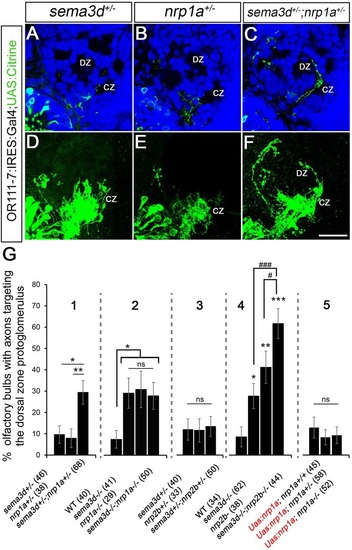Fig. 5
- ID
- ZDB-FIG-160218-12
- Publication
- Taku et al., 2016 - Attractant and repellent cues cooperate in guiding a subset of olfactory sensory axons to a well-defined protoglomerular target
- Other Figures
- All Figure Page
- Back to All Figure Page
|
sema3d interacts genetically with nrp1a to promote axon targeting of or111-7 transgene-labeled axons to the CZ. (A-C) Single optical sections through 72hpf or111-7 transgenic larvae (frontal view). Axons are in green. Dorsal is up and medial is to the right. Propidium iodide (blue) labels cell bodies revealing protoglomeruli as cell-free regions. (D-F) Maximum intensity projections of serial optical sections from the larvae shown in A-C. Scale bar: 25µm. (G) The percentage of OBs with projections to the DZ protoglomerulus. Statistical significance was estimated using two-tailed (P<0.05*, P<0.01**, P<0.001***) or one-tailed (#P<0.05, ###P<0.001) Fisher′s exact tests. Error bars represent s.e. of the sample proportion. sema3d+/-;nrp1a+/- transheterozygotic larvae (C,F; 1 in G) have an increase in projections to the DZ compared with sema3d+/- heterozygotic (A,D) or nrp1a+/- heterozygotic (B,E) siblings. sema3d-/- mutants, nrp1a-/- mutants and sema3d-/-;nrp1a-/- double mutants have a similar increase in projections to the DZ as compared with wild-type siblings (2 in G). By contrast, sema3d+/-;nrp2b+/- transheterozygotes do not have an increase in projections to the DZ when compared with sema3d+/- heterozygotic or nrp2b+/- heterozygotic siblings (3 in G). sema3d-/-;nrp2b-/- double mutants have a greater frequency of projections to the DZ than sema3d-/- or nrp2b-/- siblings (4 in G). nrp1a-/- mutants expressing the UAS:nrp1a:UAS:citrine transgene do not have an increase in misprojections to the DZ or non-protoglomerular regions as compared with wild-type or heterozygotic siblings (5 in G). CZ, central zone; DZ, dorsal zone. |
| Fish: | |
|---|---|
| Observed In: | |
| Stage: | Protruding-mouth |

